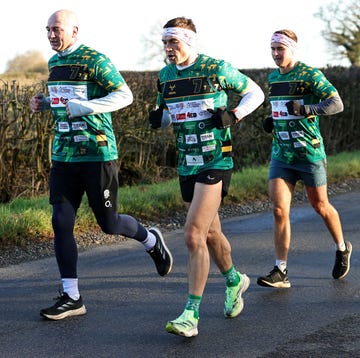The mile is just like the 1500m – but not.
Measuring 1609.34m, or 1760 yards, the mile is 109.34m longer (and possibly more painful to run) than the 1500m, and to this day is still raced regularly on the road and on the track. The only imperial distance that World Athletics recognises for official world records, the mile has retained its iconic status and somehow continued to thrive in a now-metric world of athletics.
And while the mile run has been contested for centuries, some of the finest records over that distance were achieved in the space of one month, 70 years ago. But why was the May of 1954 so mighty for the mile?
The history of the mile
The 1500m – often known as the ‘metric mile’, which encompasses three and three-quarter laps of a 400m track – has been on every Olympic schedule for men since the inaugural Games in 1896. Almost eight decades later, in 1972, the 1500m eventually became an Olympic event for women, too.
The original mile, meanwhile, is very much the older middle-distance sibling of the 1500m, having been identified since the 16th century. An English invention, the mile solidified its status as a 1760-yard event through a statute of the Parliament of England in 1593 and was later used as a distance for gambling races in the 18th and 19th centuries. Near the end of the 19th century, as running started to increase in popularity, the mile run became a staple event in both amateur and professional sport.
The fabled sub-4
Although it has never been contested at the Olympic Games or World Championships, the mile very much had its moment in the mid-20th century.
In 1954, at the running track on Iffley Road in Oxford, a 25-year-old Roger Bannister bid to become the first person to break a seemingly unfathomable time barrier for the mile: four minutes. With the then-mile world record of 4:01.3 – achieved by Sweden’s Gunder Hägg – having already stood for nine years, it didn’t seem plausible that anyone could run a mile in three-minutes-and-something-seconds.
Bannister both did and didn’t seem like the person to run a mile in under four minutes. On the one hand, he only started running seriously in 1946 at the age of 17, when he began life as a medical student at the University of Oxford. He then, for an athlete, took an incredibly light approach to training in the years that followed, having been preoccupied by the demands of his other long-term training to become a doctor.
The best running moments of 2024 running spikes in 1946, and with minimal training in the bank, Bannister ran his debut mile in 4:53. He then continued to shave off the seconds over subsequent seasons, eventually topping out at an officially recognised time of 4:03.6 – a British mile record – in May 1953.
This followed another promising performance at the 1952 Olympic Games in Helsinki, where Bannister clocked a British record of 3:46.3 in the 1500m and placed an impressive fourth overall. While Bannister was disappointed to have missed out on a medal, this was another race that made him realise that, with some more targeted interval training The best running spikes for track sessions and XC.
As such, Bannister made a concerted effort to train hard for his 1954 attempt, which fell on 6 May as part of a meet on the Iffley Road track. The wind eased just in time for him to toe the line alongside his two pacers, Chris Brasher – who later co-founded the London Marathon – and Chris Chataway. With a stopwatch recording the seconds, around 3,000 expectant spectators in the stands and enormous pressure on his back, Bannister flew round the track before famously flopping over the finish line in 3:59.4. Exhausted, the trainee junior doctor had accomplished a world first and scraped beneath the four-minute boundary with less than a second to spare.
The forgotten sub-5
Bannister’s race was broadcast live on BBC radio and met with booming applause on the track. But he wasn’t the only person to accomplish great things in the mile in May 1954. Just 23 days later, fellow Briton Diane Leather took the mile into her own hands and became the first woman in the world to run the distance in under five minutes – an outstanding feat at the time.
Active since childhood, Leather was inspired by the 1952 Olympic Games in Helsinki – where Bannister reset the British record in the 1500m – to join Birchfield Harriers, her local athletics club in Birmingham. Leather’s aptitude for middle-distance running was identified instantly and she was soon taken under the wing of coach Doris Nelson Neal, who is still remembered as a pivotal figure in the early era of women’s athletics in Great Britain.
And these really were the infant days of women’s athletics. At the time of Leather’s rise, women could run no further than 200m at the Olympics, with running being deemed hazardous to a women’s health. As such, Leather’s longer-distance potential had been curtailed by a short-sighted athletics system – in an official capacity, at least.
So, what if Leather was to run the mile anyway? Championed by Neal, Leather persisted despite official regulations and, in 1953, came spectacularly close to the five-minute mark with a 5:02.6 – a mile so rapid it became the new world best time. (Leather’s achievement was titled a ‘world best’ rather than a ‘world record’ because the IAAF – now World Athletics – did not recognise the mile as an official distance for women until 1967.)
Moving into 1954 and Leather was no less determined than Bannister to reach her mile goal. On 29 May, just over three weeks after Bannister’s seismic performance in Oxford, Leather laced up for the mile event at the Midlands Women’s AAA (Amateur Athletic Association) Championships at Birmingham’s Alexander Stadium. She had only a sub-5 on her mind, having run a painfully close 5:00.2 just three days earlier.
Charging ahead to the front of the pack, Leather went on to win the race in a world-leading 4:59.6, bettering her target time – like Bannister – by a mere fraction of a second. With her parents watching from the stands, Leather had become the first-ever women to run a mile in under five minutes – but she hadn’t peaked just yet. The British phenom went on to slice a further 15 seconds off her own mark, running a personal (and indeed world) best of 4:45.0 for the mile in 1955. This record remained unbroken for over seven years.
The competitive mile today
The mile is still a momentous distance, with thousands of athletes continuing to embrace this quirky, 1760-yard race alongside the 1500m. Indeed, thanks to developments in training, equipment and more, hundreds of men and women around the world have now run miles in under four and five minutes, just as Bannister and Leather did respectively seven decades ago.
On the women’s side, Ethiopia’s Genzebe Dibaba holds the current indoor world record for the mile, having clocked a 4:13.31 in Stockholm, Sweden, in February 2016. Faith Kipyegon of Kenya, meanwhile, ran a staggering 4:07.64 on the flat roads of Monaco to claim the outdoor mile world record in July of last year.
For the men, Yomif Keielcha of Ethiopia ran a swift 3:47.01 in March 2019 to snatch the current indoor mile world record. Even more impressive, however, is Hitcham El Guerrouj’s almost-25-year-old outdoor mile world record of 3:43.13. Regarded as one of the greatest middle-distance runners of all time, El Guerrouj achieved this yet-untouched time in Rome, Italy, in July 1999.
But that’s not all. Only a few days ago, on 25 May, fired-up athlete Josh Kerr blasted to a new British mile record of 3:45:34, beating Steve Cram’s 39-year-old national mark of 3:46.32. Competing in the Bowerman Mile at the Prefontaine Classic meet in Eugene, Oregon, Kerr won the race to rich applause, while rival Jakob Ingebrigtsen of Norway had to settle for second. (The beef between these two athletes is a spectacle in itself.) Fittingly set during this 70th anniversary month for two game-changing miles, Kerr’s British record is another sign that the mile (and Kerr) will not decline anytime soon.
Celebrating the mile elsewhere
What you need to know about popular race distances.
On 6 May – to mark 70 years exactly since the first sub-4-minute mile – thousands of everyday runners congregated in Oxford to run the Bannister Miles in the athlete’s honour. Most people (including myself) took part in a mass participation ‘Community Mile’ through the city centre, while some of the country’s best battled it out over elite miles on the now-famous Iffley Road track.
How to get started on the running track SOAR have encouraged runners of all ambitions and abilities to run a 70th The month of the mile run.
Children’s charity the NSPCC is also encouraging people to run, walk or wheel a mile on 7 June – Childhood Day – to support children who suffer abuse in the UK. You can find out more and get involved with the NSPCC’s Childhood Day Mile here.
Many mile races, too, inspire children and adults alike to move 1760 yards in whatever way they can. Held against the background of Buckingham Palace in central London, the Vitality Westminster Mile is a prime pick for runners of all ages. The next event will take place on 21 September and more details are here.
And, finally, RW ran its own team mile earlier this month in London – a first, and probably not a last.















